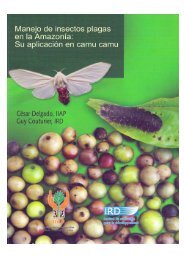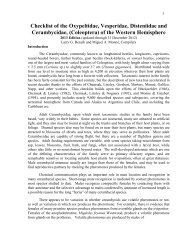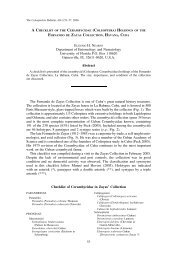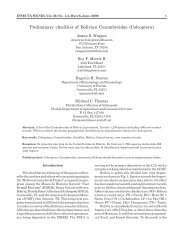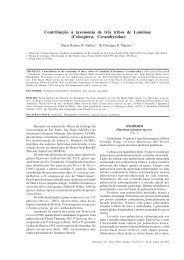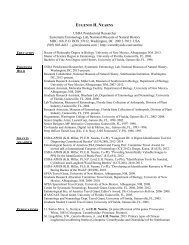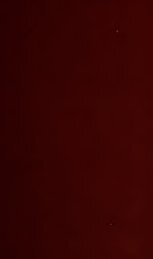You also want an ePaper? Increase the reach of your titles
YUMPU automatically turns print PDFs into web optimized ePapers that Google loves.
LAWRENCE S. DILLON <strong>AND</strong> ELIZABETH S. DILLON 181<br />
MALE. Elongate-ovate, mther robust, subcyiindrica!; head black, pronotum<br />
and elytrn dark reddish-brown. Head covered with dark grayish-brown and fulvQus<br />
gray pubescence, with two indistinct, parallel, darker vittae above, widest on occiput;<br />
front narrowly margined with fulvous-gray on sides. Pronotum fulvous-gray<br />
pubescent, mottled with dark brown, medially narrowly fulvous vittate, either side<br />
of disk with irregul3r, small, fulvous mneulae. Scutellum dark fulvous at bn.se,<br />
margined narrowly with gray along sides and apex. Elytra on basal third dark<br />
brown pubescent, variegated witb lulvous-gray, rest fulvous-gray pubescent, with<br />
scattered, small, dark brown maculae; just behind middle each with a rather broad,<br />
V-shaped, dark hrown macula, within the V at tbn angle an indistinct, elongate, fulv<br />
ous spot. Body bennath dark reddish-brown, rather densely covered with fulvous<br />
gray IJUbescence; metasternum on extreme lateral margin apically with a small,<br />
round, dark brown mncula; abdominal sternitcs laterally more fulvQus. Legs dark<br />
brown, thinly clothed with fu!vous-gray, somewhat variegated with clark brown.<br />
Antennae dark reddish-brown, very thinly covered with gray pubescence, at base<br />
indistinctly annulate from fourth segment; scape blnck, thinly dark brown pubes<br />
cent.<br />
Head with a median impressed line from occiput nearly to epistoma; front con<br />
cave between antennal tubercles, very finely, densely punctate, with a number of<br />
large punctures interspersed; genae feebly vertical, very finely, denscly punctate,<br />
with a fcw larger interspersed punctures; eye with lower lobe oblong-ovate, one<br />
and one-third times the height of the gen:\ ; antennal tubercles prominent, at apex<br />
with an elongate, acute horn directed anteriorly. Pronotum transverse; sides feebly<br />
arcuate, narrowed apically, laterally armed with a very feeble tubercle, which ends<br />
in a. short" obtw;e process; an .'l.picnl and a basal transverse sulcus, the basal one<br />
not oblique laterally; di£k medially near base with a feebly elevated, slightly elongate<br />
tubercle, either side uneven and somewhat rugose, base with a number of punc<br />
tate-grallules. Scutellum strongly transverse, sides nearly straight, oblique, apex sub<br />
truncate. Elytra with sides almost straight, feebly arcuate posteriorly to tips, apices<br />
separately rounded; disk basally feebly gibbose, the entire bas:!l third densely,<br />
finely punctate, becoming rugose behind humeri on sides, rest with rather con.rse<br />
punctures placed one in each of the da.rk brown maculae; humeri prominent, the<br />
anterior m:trgin curved, the angle with a moderate-sized tuberele. Prosternum<br />
widened rather strongly behind middle; mesosternal process emarginnte at apex.<br />
Proooxae prominent, with a long, rather robust uncus anteriorly; femora clavate,<br />
profemora very robust, slightly expanded apically, moderately, transversely rugose<br />
on entire anterior face and on baSal two-thirds of posterior face; protarsi somewhat<br />
dilated. Fifth sternite one-half again as long as fourth, apex feebly emarginate.<br />
Antennae twice or more the length of body, fimbriate feebly on scape, rather heavily<br />
so on third and fourth segments, and slightly on fifth ; scape short, not attaining<br />
middle of pronotum, rather suddenly clavate on apical third, with four or five deep<br />
grooves at hase beneath, rest of surface finely, densely punctate; third segment in<br />
distinctly bisinuate, twice as long as first ; rest subequal in lnngth ; eleventh elongate.<br />
FEMALE. More robust. in body form; antenna! tubercles not armed at apex;<br />
pronotal lateral tubercles with the terminal process slightly more elongate; procoxae<br />
with very small, obtuse tubercles; profemora less robust, gradually clavate, very<br />
feebly rugose on basal half; fifth sternite twice length of fourth, apex retuse, medi<br />
ally with an elongate triangular impression, with an impressed line as well; antennae



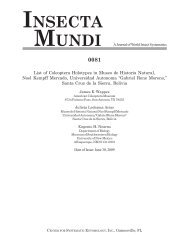
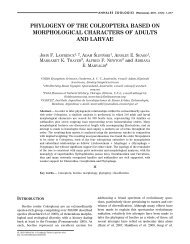


![Coleoptera. Vol. I. [Longicornia. Part I.]](https://img.yumpu.com/41202793/1/180x260/coleoptera-vol-i-longicornia-part-i.jpg?quality=85)
